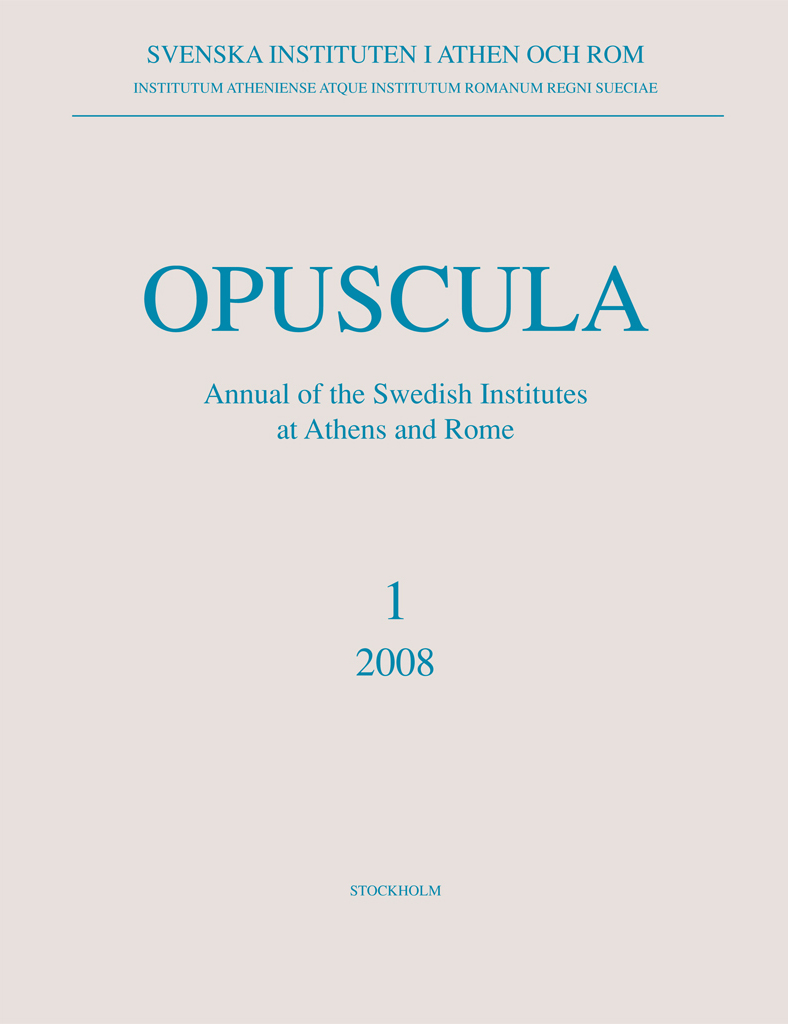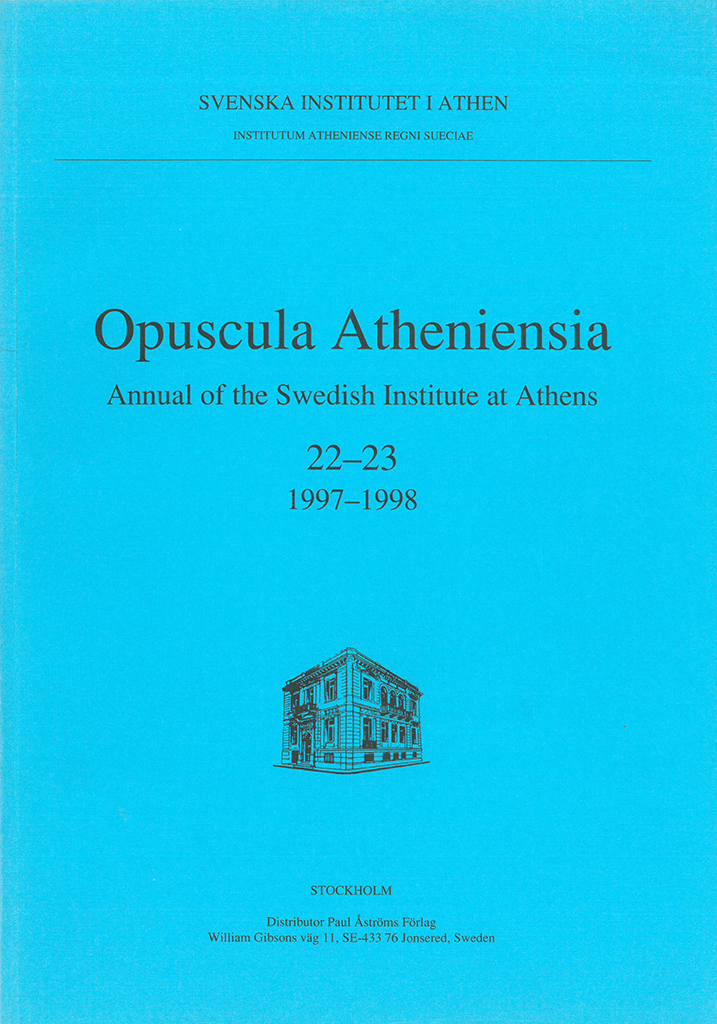Opuscula 15 is published by the Swedish Institutes at Athens and Rome. Distributed by Eddy.se AB. View volume at ERIH PLUS. The Basilica Sempronia and the Forum Romanum By Henrik Gerding & Nicolò Dell’Unto Abstract The authors of this paper reinvestigate the remains of the Basilica Sempronia, situated below the Imperial Basilica Julia in Rome. By combining the information from the original excavation with a new 3D digital documentation, new observations are made and previous interpretations reassessed. The present remains are discussed in relation to the contemporary built environment, as well as to preceding and following phases. It is argued that the Basilica Sempronia was an elongated hall with closed lateral walls and interior supports. It was erected on a podium that raised the building above the surrounding streets on all sides except the west. The Augustan renewal of the Basilica Julia entailed vast foundations works, which had a huge impact on the site. However, evidence of an intermediate phase indicates the existence of a building complex that merged the previous basilica with the Tabernae Veteres, partly preserving their original dimensions and orientations. This intermediate basilica complex comprised a large paved unroofed surface at an elevated position, possibly a peristyle…
Opuscula 14 is published with open access. Printed edition distributed by Eddy.se AB. Also available at Amazon.com, Adlibris, and Bokus. View volume at ERIH PLUS. The topography of Hermione—A preliminary outline By Henrik Gerding (Lund University, Sweden) Abstract The preliminary results of a survey of ancient Hermione (epichoric Hermion) are presented in this paper. The survey was conducted during three short campaigns over the period 2015–2017, and focused on the urban layout and development of the ancient city. Because the ancient city area more or less coincides with modern Ermioni, the investigation was mainly restricted to the documentation and analysis of architectural remains that were both still visible above ground and accessible. However, the report also includes a thorough re-evaluation of previous scholarship, taking into consideration remains that are no longer visible. The author identifies three questions of particular interest, relating to the exact location, extent, and potential relocation of the ancient city, and points to the lack of a coherent interpretation. On the basis of present data, the author proposes that Hermione was indeed relocated to a new site, less than 1 km away from its original position, in the early 3rd century BC, and highlights the urban, social,…
Opuscula 9 (2016) is now available for purchase and free download at bokorder.se Also available at Amazon.com, Amazon.de, Bokus.com and Adlibris.com. Later, laterculus, and testa. New perspectives on Latin brick terminology By Henrik Gerding Abstract For centuries antiquarians and archaeologists have tried to reconcile the terminology of ancient writers on architecture, such as Vitruvius, with the perceived realities of the material record. One particular issue of debate concerns the interpretation of different words for “brick” in Latin. In this paper it is argued that earlier attempts to settle this question are unsatisfactory and leave several problems unresolved. A thorough examination of literary and epigraphic sources, combined with new insights in Hellenistic brick usage, suggests that primary distinctions in Latin brick terminology were based on shape and size, rather than on a mere division between fired and unfired bricks. Thus, it is argued that later basically signified a large moulded block, but normally was used to indicate mud bricks; that laterculus changed over time from being a diminutive (a small later) to becoming the standard term for the relatively thin fired bricks of the Roman Imperial period; and that testa originally and primarily signified a fragment of a roof tile (or…
Opuscula 4 (2011) is now available for purchase and free download at Bokorder.se. Also available at Amazon.com, Amazon.de, Bokus.com, and Adlibris.com. A courtyard gate at Thourioi By Henrik Gerding Abstract In the early seventies Paola Zancani Montuoro suggested that a large paved structure, which had recently been uncovered at the site of Sybaris/Thourioi in southern Italy, was the remains of an ancient neosoikos, or shipshed. This idea quickly gained widespread acceptance and is still often repeated, despite some objections having been raised. In this paper it is argued that the structure, which cannot have been a shipshed, was actually a courtyard gate belonging to the Late Classical or Early Hellenistic city wall of Thourioi. Bibliographical information Henrik Gerding, ‘A courtyard gate at Thourioi’, Opuscula. Annual of the Swedish Institutes at Athens and Rome (OpAthRom) 4, 7–18. Stockholm 2011. ISSN: 2000-0898 ISBN: 978-91-977798-3-8. Softcover, 168 pages. https://doi.org/10.30549/opathrom-04-02
Opuscula 1 (2008) is out of print. Available for free download at Bokorder.se. Used copies might be available at Amazon.com and Amazon.de. Reconsidering the tomb of Aulus Hirtius By Henrik Gerding Abstract Since its discovery, the tomb of Aulus Hirtius in Rome has been regarded as a firmly dated monument and, thus, constituted a widely used fixed point for those tracing the early development of Roman brick architecture. However, several peculiarities regarding the construction of the tomb and its inscriptions strongly indicate that the present dating, which is based on historical sources, may not be correct. In this note it is suggested by the author that the original tomb was destroyed and thoroughly remodelled in the early or mid-Augustan period. Some general implications of this regarding the introduction of brick architecture in Rome are also considered. Bibliographical information Henrik Gerding, ‘Reconsidering the tomb of Aulus Hirtius’, Opuscula. Annual of the Swedish Institutes at Athens and Rome (OpAthRom) 1, 145–154. Stockholm 2008. ISSN: 2000-0898. ISBN: 978-91-977798-0-7. Softcover, 198 pages. https://doi.org/10.30549/opathrom-01-11
Distributed by Astrom Editions. Contents Marie-Françoise Billot | Sanctuaire et cultes d’Athéna à Argos (pp. 7–52) Hélène Borrman, Mascot Fjaestad-Seger, E. Urban Engström & Paul Åström | A dental radiographic examination of a Late Bronze Age skull from Kition (pp. 53–56) Katie Demakopoulou, Nicoletta Divari-Valakou, Paul Åström & Gisela Walberg | Excavations in Midea 1995–1996 (pp. 57–90) Johan Flemberg | An Anadyomene in the Milles Collection (pp. 91–101) Barbro Santillo Frizell | Monumental building at Mycenae. Its function and audience (pp. 103–116) Jane F. Lloyd | The Minoan hall system and the problem of an entrance to the South House at Knossos (pp. 117–140) G.H.R. Wright | Puer aeternus in prehistoric Cyprus (pp. 141–146) Miscellanea Göran Henriksson & Mary Blomberg | Petsophas and the summer solstice (pp. 147–151) Penelope A. Mountjoy | An octopus stirrup jar from Kalymnos (pp. 152–154) In memoriam Alfred Westholm (written by Paul Åström) (p. 155) Erik Holmberg (written by Paul Åström) (p. 156) Book reviews Henrik Gerding | P. James et al., Centuries of darkness. A challenge to the conventional chronology of Old World archaeology (pp. 157–160) Gunnel Ekroth | C.M. Antonaccio, An archaeology of ancestors. Tomb cult and hero cult in early Greece (pp….






